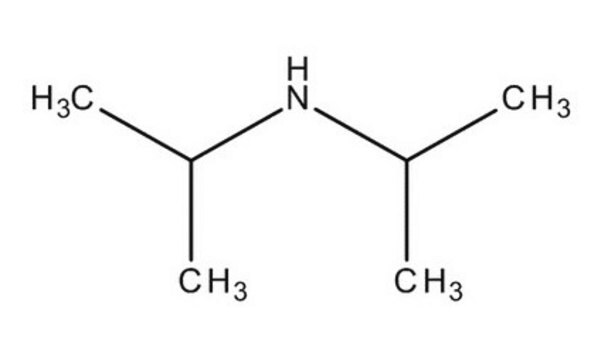38292
Diisopropylamine
analytical standard
Synonym(s):
DIPA
About This Item
Recommended Products
grade
analytical standard
Quality Level
vapor density
3.5 (vs air)
vapor pressure
50 mmHg ( 20 °C)
assay
≥99.5% (GC)
autoignition temp.
599 °F
shelf life
limited shelf life, expiry date on the label
expl. lim.
8.5 %
technique(s)
HPLC: suitable
gas chromatography (GC): suitable
refractive index
n20/D 1.392 (lit.)
n20/D 1.392
bp
84 °C (lit.)
mp
−61 °C (lit.)
solubility
H2O: soluble 110 g/L at 25 °C (completely)
density
0.722 g/mL at 25 °C (lit.)
application(s)
environmental
format
neat
SMILES string
CC(C)NC(C)C
InChI
1S/C6H15N/c1-5(2)7-6(3)4/h5-7H,1-4H3
InChI key
UAOMVDZJSHZZME-UHFFFAOYSA-N
Looking for similar products? Visit Product Comparison Guide
General description
Application
Recommended products
signalword
Danger
Hazard Classifications
Acute Tox. 3 Inhalation - Acute Tox. 4 Oral - Aquatic Chronic 3 - Eye Dam. 1 - Flam. Liq. 2 - Skin Corr. 1B - STOT SE 3
target_organs
Respiratory system
Storage Class
3 - Flammable liquids
wgk_germany
WGK 2
flash_point_f
7.8 °F - closed cup
flash_point_c
-13.45 °C - closed cup
ppe
Faceshields, Gloves, Goggles, type ABEK (EN14387) respirator filter
Choose from one of the most recent versions:
Certificates of Analysis (COA)
Don't see the Right Version?
If you require a particular version, you can look up a specific certificate by the Lot or Batch number.
Already Own This Product?
Find documentation for the products that you have recently purchased in the Document Library.
Our team of scientists has experience in all areas of research including Life Science, Material Science, Chemical Synthesis, Chromatography, Analytical and many others.
Contact Technical Service








